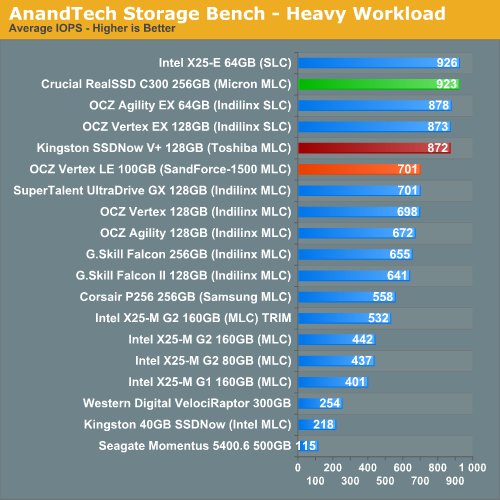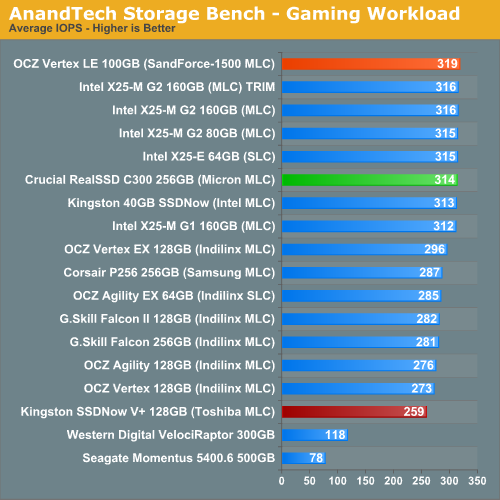OCZ’s Vertex Limited Edition Review & SSD State of the Union
by Anand Lal Shimpi on February 19, 2010 12:00 AM EST- Posted in
- Storage
AnandTech Storage Bench
Note that our 6Gbps controller driver isn't supported by our custom storage bench here, so the C300 results are only offered in 3Gbps mode.
The first in our benchmark suite is a light usage case. The Windows 7 system is loaded with Firefox, Office 2007 and Adobe Reader among other applications. With Firefox we browse web pages like Facebook, AnandTech, Digg and other sites. Outlook is also running and we use it to check emails, create and send a message with a PDF attachment. Adobe Reader is used to view some PDFs. Excel 2007 is used to create a spreadsheet, graphs and save the document. The same goes for Word 2007. We open and step through a presentation in PowerPoint 2007 received as an email attachment before saving it to the desktop. Finally we watch a bit of a Firefly episode in Windows Media Player 11.
There’s some level of multitasking going on here but it’s not unreasonable by any means. Generally the application tasks proceed linearly, with the exception of things like web browsing which may happen in between one of the other tasks.
The recording is played back on all of our drives here today. Remember that we’re isolating disk performance, all we’re doing is playing back every single disk access that happened in that ~5 minute period of usage. The light workload is composed of 37,501 reads and 20,268 writes. Over 30% of the IOs are 4KB, 11% are 16KB, 22% are 32KB and approximately 13% are 64KB in size. Less than 30% of the operations are absolutely sequential in nature. Average queue depth is 6.09 IOs.
The performance results are reported in average I/O Operations per Second (IOPS):

Under a typical, light poweruser workload, the Crucial RealSSD C300 bests OCZ's Vertex LE by 4.5% - not a tangible difference, just a (barely) measurable one. Intel's SLC X25-E is actually still the fastest thing here, which must be frustrating for Intel since the only thing separating the G2s from topping the charts is sequential write speed.
The Toshiba based Kingston drive performs similarly to the MLC based Indilinx drives, which is good since that's exactly where it's supposed to perform.
If there’s a light usage case there’s bound to be a heavy one. In this test we have Microsoft Security Essentials running in the background with real time virus scanning enabled. We also perform a quick scan in the middle of the test. Firefox, Outlook, Excel, Word and Powerpoint are all used the same as they were in the light test. We add Photoshop CS4 to the mix, opening a bunch of 12MP images, editing them, then saving them as highly compressed JPGs for web publishing. Windows 7’s picture viewer is used to view a bunch of pictures on the hard drive. We use 7-zip to create and extract .7z archives. Downloading is also prominently featured in our heavy test; we download large files from the Internet during portions of the benchmark, as well as use uTorrent to grab a couple of torrents. Some of the applications in use are installed during the benchmark, Windows updates are also installed. Towards the end of the test we launch World of Warcraft, play for a few minutes, then delete the folder. This test also takes into account all of the disk accesses that happen while the OS is booting.
The benchmark is 22 minutes long and it consists of 128,895 read operations and 72,411 write operations. Roughly 44% of all IOs were sequential. Approximately 30% of all accesses were 4KB in size, 12% were 16KB in size, 14% were 32KB and 20% were 64KB. Average queue depth was 3.59.

I ran and re-ran the tests - they're accurate. The Vertex LE does well, just not as good as the Kingston or Crucial drives here. The Crucial RealSSD C300 is simply a beast in our write-heavy test. I suspect that the fact that many of our writes here are compressed is to blame for the Vertex LE not being as fast as usual here. Remember that SandForce's architecture works by data reduction, whether through compression, deduplication or other similar natured algorithm. By definition those algorithms don't work well on data that is already being written in reduced form. If you're dealing with a lot of compressed archives, the Vertex LE will perform well, but not as well as the RealSSD C300.
Our final test focuses on actual gameplay in four 3D games: World of Warcraft, Batman: Arkham Asylum, FarCry 2 and Risen, in that order. The games are launched and played, altogether for a total of just under 30 minutes. The benchmark measures game load time, level load time, disk accesses from save games and normal data streaming during gameplay.
The gaming workload is made up of 75,206 read operations and only 4,592 write operations. Only 20% of the accesses are 4KB in size, nearly 40% are 64KB and 20% are 32KB. A whopping 69% of the IOs are sequential, meaning this is predominantly a sequential read benchmark. The average queue depth is 7.76 IOs.

Just as we saw with our PCMark tests, all of the drives perform about the same here. If you're just going to be tossing games on your SSD, you can't really go wrong with any of these drives. It's possible that if we were able to use our 6Gbps controller here that Crucial would break the mold as the drives here appear to be limited by sequential read speed.










83 Comments
View All Comments
v12v12 - Tuesday, February 23, 2010 - link
"To calm your fears, OCZ is selling the Vertex LE with a 3 year warranty."Umm 3yrs is CRAP! It's the industry standard among ALL HDs... again, how many times do I have to catch Anand-staff soft-wrist-slapping these con-artist manufacturers?! Who's "assured" with a 3yr warranty vs what? I haven't seen any manu offering lower? So how's that a selling/assurance point... let alone if it's even VALID to list in this article?
What you should have said (if at all) was:
"To calm your fears, OCZ is selling the Vertex LE with a STANDARD 3 year warranty (just like everyone else)." Hahaha.
I just don't get how you can continue to soft-scold (more like a notation) these manufactures when you and I KNOW it's crap. Well Okay I DO know; you're smart and running a business/review site (pro-business) and you don't wanna bad mouth these guys like you OUGHT to do. So instead you'll give them wrist slaps at the end of all the journalist-sensationalism in order to wash over the apparent chicanery of these businesses, so they'll keep sending you beta/new samples... Yes I know how the POLITICS of "business" works these days; sucks for the avg-minded consumer who totally misses keystone issues like this for all the hype and grandeur laced commentary... Sigh, the consumer-cattle loses again.
OWC Grant - Tuesday, February 23, 2010 - link
FWIW to this discussion thread and wasn't covered in the brief mention, the OWC Extreme Enterprise comes with an enterprise class level warranty...FIVE years. So, based on pricing and other similarities, will leave it up others to decide what the best value/performance ratio is in SSDs.kunedog - Tuesday, February 23, 2010 - link
Let's also not forget that he *never* acknowledged the near-immediately stratospheric pricing of Intel's G2 X-25M, right after he praised its affordability:http://www.anandtech.com/storage/showdoc.aspx?i=36...">http://www.anandtech.com/storage/showdoc.aspx?i=36...
He mentioned the firmware problems and lack of stock once but never the pricing.
ONLY now, over 6 months later, do we see prices anywhere near what he predicted at release:
80GB for $220
http://www.newegg.com/Product/Product.aspx?Item=N8...">http://www.newegg.com/Product/Product.aspx?Item=N8...
160GB for $430
http://www.newegg.com/Product/Product.aspx?Item=N8...">http://www.newegg.com/Product/Product.aspx?Item=N8...
The 160GB comes with a free Apricorn USB enclosure, the same one "randomly plugged" here by Anand. It's a strange coincidence to see two sites decide to associate it with SSDs (why would you put an SSD in an USB enclosure?).
shin0bi272 - Monday, February 22, 2010 - link
I thought I saw a review on anandtech a few months ago about the corsair p128 which was supposed to be a great ssd. But its not included on these benchmarks. Its supposed to have 220mb seq read and 200mb seq write. yet its not included? why?OWC Grant - Monday, February 22, 2010 - link
Glad to see so much interest in SSD!As Anand was made aware, our earliest units went out to reviewers and we contacted him and other reviewers to get these units back upon learning of a firmware revision that became available early Feb. In direct communication with him, he noted that neither firmware version had any effect on the performance.
All other OWC SSD units in the field (and available with same day to 1 day delay shipping from OWC) do have the latest firmware revision.
So, we are not "a bit behind OCZ" in this regard.
Hope this clears up the matter...and that you get an OWC SSD for yourself!
smith11 - Monday, February 22, 2010 - link
There's something that I'm not getting...If there's 0.5x write amplification because of real-time compression, why wouldn't the effective capacity be a good bit higher than (the non-reserved part of) the physical capacity ???
GullLars - Monday, February 22, 2010 - link
When i was reading this test, i couldn't help but think on several occasions that a cheap RAID of 3-4 intel x25-V from ICH10R would beat many of the drives tested here, and at a lower price.4 x25-V in RAID 0 gives 160GB capasity, roughly 600 MB/s seq read (limited by ICH10Rs bandwidth), about 140-150 MB/s seq write, around 100.000 4KB random read IOPS (400MB/s) at higher queue depths, and about 40.000 4KB random write IOPS (120MB/s). At a price point around $400-450, wich is about the same as Intel x25-M G2 160GB costs...
I think it would be great if Anand could do a test with 4 x25-V in RAID 0 from ICH10R to demonstrate a budget concious enthusiast setup.
semo - Monday, February 22, 2010 - link
Hi Anand,Great article. Any word on PCI-e SSDs? Are you leaving them out because of high costs or other reasons?
Also, good to know that you have our backs if those SSDs start crapping out. Without people like you companies get away with it for a long time.
rubbertoe - Sunday, February 21, 2010 - link
Looks like Amazon is also selling the 100G version:http://www.amazon.com/gp/product/B0035RQZSG/ref=pd...">http://www.amazon.com/gp/product/B0035R...X0DER&am...
Can someone confirm this is the drive that was reviewed? With selling only 5,000 does anyone have any idea how they will be distributed into the retail channels?
RT
neoflux - Sunday, February 21, 2010 - link
The OCZ Agility uses Intel 50nm or Toshiba 40nm flash.The OCZ Solid 2 uses Intel 34nm flash.
The OCZ Vertex uses Samsung flash, but what SIZE?
And based on that size, if the controller is the same as Anand mentioned a few articles ago, is the Solid 2 faster or at least the same speed-wise as the Vertex?
I did find that the Solid 2 may actually have some sort of 'crippled' Indilux controller, but that was just some forum, not an article.
I have gone back through all the Anand articles and googled everything I could think, but could not find the answer.
Someone enlighten me as to the size of the flash and the speed compared to the Vertex?